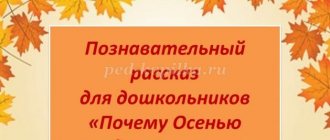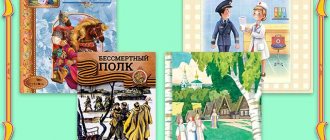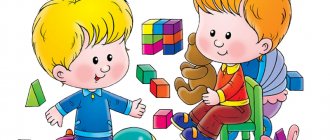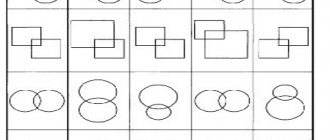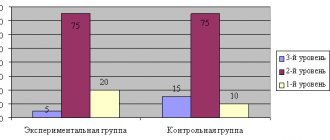The role of children's fiction in the formation of personality and all-round development of the child
Introduction
Preschool childhood as a period in human life plays an important role in shaping what not only each individual person will become, but also all of humanity and the world as a whole. The educational, ideological, moral, and cultural priorities laid down in preschool childhood determine the life path of generations and influence the development and state of the entire civilization.
The importance of introducing children to the beauty of their native word and the development of a culture of speech was pointed out by teachers, psychologists, and linguists (K. D. Ushinsky, E. I. Tikheyeva, E. A. Flerina, L. S. Vygotsky, S. L. Rubinshtein, A. V. Zaporozhets, A. A. Leontyev, F. A. Sokhin, A. M. Shakhnarovich, L. I. Aidarova, etc.)
Fiction accompanies a person from the first years of his life, and in preschool childhood the foundation is laid on which all subsequent acquaintance with the vast literary heritage will be based. Reading books to children serves as one of the conditions for the development of hearing, and on this basis, the acquisition of language.
Fiction serves as a powerful, effective means of mental, moral, and aesthetic education of children, and has a huge impact on the development and enrichment of a child’s speech. It enriches emotions, cultivates imagination and gives the child excellent examples of the Russian literary language.
These examples differ in their impact: in stories, children learn conciseness and precision of words; the poems capture the musicality, melodiousness, and rhythm of Russian speech; folk tales reveal to them the accuracy and expressiveness of the language, show how rich their native speech is in humor, lively and figurative expressions, and comparisons. (N.S. Karpinskaya).
Preschool children are listeners, not readers; a work of art is conveyed to them by an adult.
The love he developed for books in preschool will stay with him forever. Anyone who reads knows a lot. If a child understands the content of what he read, it means he thinks, analyzes, and reasons.
Introducing children to fiction gives better results if the efforts of educators and parents are combined.
The relevance of the problem of literary education for preschool children at the present stage is due to the fact that children are increasingly becoming acquainted with fiction through the Internet and television. In recent decades, there has been a decline in interest in books among both adults and children, resulting in a decrease in the personal culture of preschool children. With the advent of television and computers, the flow of information hit people with unprecedented force. Children master the computer before they learn to read, and navigate the keyboard better than the table of contents of books. In this regard, we, teachers of a preschool educational institution, are concerned with how to pedagogically correctly develop creativity in the perception of books, enrich the spiritual and cultural level of pupils. In the general system of personal development of the younger generation, the question of the peculiarities of children’s perception of books is one of the most pressing in psychology and pedagogy today. The main factor in a child’s attitude towards a book and the criteria for its evaluation is the presence or absence of interest in reading.
Modern children spend more and more time playing computer games and watching TV. Sociological research in our country and abroad has revealed negative trends: interest in reading among younger preschoolers and adolescents is noticeably reduced; The share of reading in children's free time has been sharply reduced. Many modern children do not know the heroes of good old fairy tales, preferring to them the heroes of blockbusters and computer games. Of course, every time has its own literary heroes, but it is no coincidence that fairy tales and legends have been passed down from generation to generation for many years and serve as an excellent educational tool.
Children have stopped reading, which means literacy, intelligence, emotional and moral education, and many components of harmonious personal development suffer.
Without reading, a person does not develop, does not improve his intellect, memory, attention, imagination, does not assimilate and use the experience of his predecessors, does not learn to think, analyze, compare, and draw conclusions. The book, on the contrary, makes it possible to speculate, to “fantasize.” It teaches you to think about new information, develops creativity, artistic abilities, and the ability to think independently.
Fiction serves as a powerful, effective means of mental, moral and aesthetic education of children; it has a huge impact on the development and enrichment of children's speech.
In poetic images, fiction reveals and explains to the child the life of society and nature, the world of human feelings and relationships. It makes emotions more intense, fosters imagination and gives preschoolers excellent examples of the Russian literary language.
Our task is to introduce pupils to children's literature and children's reading, interacting with parents. We want our children to be literate readers. In order to raise a reader in a child, the adult himself must show interest in the book, understand its role in a person’s life, know those books that will be important for the child, follow the latest in children’s literature, be able to have an interesting conversation with the child, and be sincere in expressing one’s feelings.
The role of children's fiction in the formation of a child's personality and speech development.
Children's books are considered as a means of mental, moral and aesthetic education. Children's poet I. Tokmakova calls children's literature the fundamental basis of education. According to V. A. Sukhomlinsky, “reading books is the path along which a skillful, intelligent, thinking teacher finds the way to a child’s heart.” Fiction shapes moral feelings and assessments, norms of moral behavior, and cultivates aesthetic perception.
Works of literature contribute to the development of speech and provide examples of the Russian literary language. E. A. Flerina noted that a literary work provides ready-made linguistic forms, verbal characteristics of the image, definitions with which the child operates. By means of artistic expression, even before school, before mastering grammatical rules, a small child practically masters the grammatical norms of the language in unity with its vocabulary.
N. S. Karpinskaya also believed that a fiction book provides excellent examples of literary language. In stories, children learn laconicism and precision of language; in poetry - musicality, melodiousness, rhythm of Russian speech; in fairy tales - accuracy, expressiveness.
From the book, the child learns many new words and figurative expressions, his speech is enriched with emotional and poetic vocabulary. Literature helps children express their attitude to what they have heard, using comparisons, metaphors, epithets and other means of figurative expression.
When reading the book, the connection between speech and aesthetic development clearly appears; language is assimilated in its aesthetic function.
The development of speech is closely related to the development of consciousness, knowledge of the surrounding world, and the development of the personality as a whole.
Research by domestic psychologists and psycholinguists has proven that mastering speech does not just add something to a child’s development, but rebuilds his entire psyche and all his activities. (Alekseeva M.M., Yashina B.I. Methodology for the development of speech and teaching the native language of preschoolers: A textbook for students of higher and secondary education, pedagogical educational institutions. - 3rd ed., stereotype. - M. : Publishing House, 2000. - 400 pp.)
The native language is a means of mastering knowledge and studying all academic disciplines in school and subsequent education. Based on a long study of the processes of thinking and speech, L. S. Vygotsky came to the following conclusion: “There is every factual and theoretical basis to assert that not only the intellectual development of a child, but also the formation of his character, emotions and personality as a whole is directly dependent on speech" (Vygotsky L.S. Mental development in the learning process).
In poetic images, fiction reveals and explains to the child the life of society and nature, the world of human feelings and relationships. It enriches emotions, cultivates imagination and gives the child excellent examples of the Russian literary language. These examples differ in their impact: in stories, children learn conciseness and precision of words; the poems capture the musicality, melodiousness, and rhythm of Russian speech; folk tales reveal to them the accuracy and expressiveness of the language, show how rich their native speech is in humor, lively and figurative expressions, and comparisons.
Family reading is of particular importance for a child’s reading destiny. Reading together brings adults and children together, stimulates and fills rare and joyful moments of spiritual communication with content, and cultivates a kind and loving heart in a child.
Family reading traditions are a very important part of the family education system. Family reading is not a way to get information, it is the most important and best way of communication and unobtrusive education, which is the most effective. Parents, through family reading, help to instill an interest in reading in children.
A successful find in working with parents is the project method.
Today it is becoming more and more widely used in the pedagogical practice of our institution. The project method is the training and education of a child through activities, and when working with families, through the joint activities of children and parents.
Priority of thematic weeks
Working on thematic weeks increased teachers’ interest in creating projects and using active forms of interaction. The main goal of working on thematic weeks is to systematize, deepen, and generalize children’s knowledge on a specific topic.
The theme of the week allows you to combine all types of children's activities, make them interesting, and as useful as possible for children. Activities held during the theme week contribute to the development of creative interaction between students, teachers, preschool specialists, and parents. Various forms of events are used: travel games, educational activities, observations, excursions, exhibitions, experiments...
Thematic planning in a preschool educational institution allows you to make a child’s life interesting, creative, varied, gives him the opportunity to immerse himself in a topic and better understand it.
Thematic weeks are a comprehensive form of methodological and educational work that unites all participants in the pedagogical process around a current problem. They involve the implementation of such an approach to the implementation of methodological and educational work in kindergarten, which allows you to involve teachers, parents and children in active search, research and creative activities.
Advantages of this approach:
— high efficiency due to the inclusion of each participant in active activities;
— development of flexibility of thinking, the opportunity to express one’s individuality and creativity;
— an opportunity for reflection, analysis and evaluation of one’s activities (feedback);
— the opportunity to introduce integrated forms of organizing the educational process into the practice of preschool educational institutions; variability in the use of forms and methods of work with both adults and children;
- an opportunity to involve parents in children's activities as equal communication partners;
— an opportunity for prompt and at the same time systematic solutions to current problems;
— the emergence of conditions for the unity of all participants in the pedagogical process, the formation of kindergarten traditions;
- an opportunity to enrich the subject-development environment of a preschool educational institution, for fruitful interaction with the surrounding society.
Thematic weeks are based on the principle of integrating different types of activities that affect all areas of the child’s personality development.
One of the pedagogical conditions for the effectiveness of the thematic week is the interaction of preschool specialists, educators and parents, aimed at creating favorable conditions for the development and self-expression of children.
The topic should be relevant, interesting and pedagogically appropriate. Thematic weeks are characterized by a clear structure, subject to a specific algorithm, including the phased implementation of all components.
Educational project “Book Week”
Project duration: 1 week (from 03/30/2015 to 03/03/2015)
Age of children : senior group (5 – 6 years old)
Project goals:
— attracting the attention of teachers and parents to the problem of using children's books and literary works;
— introduction into practice of various forms and methods of working with literary works that contribute to the familiarization of children with books for the development of cognitive, creative and emotional activity of children;
— to involve parents in joint creativity within the framework of “Book Week”;
— to cultivate a desire for constant communication with the book and caring for it.
— updating the importance of parents’ participation in the formation of children’s book culture, creating conditions for the active introduction of literary experience into the creative activities of students.
Project objectives:
| Children | Parents | Teachers |
| - introducing preschool children to fiction, - developing interest in books and children's reading, acquiring a stock of literary artistic impressions, and listener experience; — fostering a value-based attitude towards a book as a work of art; — formation of the personal position of preschool children both in the perception of literary works and in the creative process; — development of cognitive, creative and emotional activity in the process of introducing preschoolers to literature; - expanding children's horizons, enriching and activating vocabulary (cover, binding, illustration, typography, font, manuscript, parchment, papyrus, birch bark, encyclopedia, dictionary, etc.); — development of children’s creative abilities to express their impressions in various types of productive activities; — developing in children the skills of cooperation with peers and adults in the process of joint activities. | — introducing a variety of methods of working with books into the practice of family education — involving parents in creating conditions for developing children’s interest in books at home and in kindergarten; — increasing parental competence in the process of children's reading. | -increasing the professional level of teachers on organizing work with books and literary works; — activation of the creative potential of teachers; — development of methodological materials “Working in the book corner” (card index of games, methods and techniques for working with literary works, notes for classes, leisure and other events); — introduction into pedagogical practice of various forms and methods of working with literary works for the development of cognitive, creative and emotional activity of children. |
Methods:
— Visual (organization of exhibitions, presentations, book corners, etc.)
— Verbal (conversations, quizzes, competitions, literary riddles, etc.)
- Practical (cognitive - speech and productive activities of children, excursion to the library, participation of children in holidays and leisure activities).
Progress of the event
| Monday | ||
| The first half of the day | Grand opening of "Children's Book Week". (Holds out in the music room). Invited guests (librarians) conduct a conversation with children on the topic “It’s the book’s birthday!” (a message about where and when “Children’s Book Week” was born); Message from a librarian about books celebrating anniversaries. Game “Fairy Tales. Fairy tales. Fairy tales" (Appendix 1) Inviting children to visit the Library. | |
| Afternoon | Excursion to the library. Let's get acquainted with the work of book curators. (Play as a plot-role-playing game “Journey to the World of Books”). | |
| Tuesday | ||
| The first half of the day | Preparation for the theatrical performance “Fly – Tsokotukha”. Creative workshop: preparing decorations (masks, outfits, attributes for a fairy tale - samovar, big money, cups, etc.) We invite parents to take part in preparing for the performance. | |
| Afternoon | Organization of the plot-role-playing game: “Book “Ambulance” (together with the children we “treat” books). (Prepare “medical” gowns, caps, glasses, bandages - tape, glue, stretchers, etc.) | |
| Wednesday | ||
| The first half of the day | Making handwritten homemade books - “Little Books” (joint creativity of children and parents, children and teachers); Design of exhibitions based on the results of creativity. | |
| Afternoon | Literary quiz “Journey through fairy tales” Taken together with parents. (Appendix 2) | |
| Thursday | ||
| The first half of the day | Artistic creativity (drawing): “My favorite fairy-tale hero.” Round dance games with playful choruses: “Birch”, “Seal”. (Appendix 3) | |
| Afternoon | Exhibition of children's drawings based on fairy tales. “Turnip” Folk game – entertainment. (Appendix 4) | |
| Friday | ||
| The first half of the day | Organization of the plot-role-playing game “Bookstore”. Exhibition of children's drawings based on fairy tales. | |
| Afternoon | Closing ceremony of Book Week. Exchange of “Little Books” as souvenirs. Theatrical performance “Fly – Tsokotukha” (in the music room for children and parents of other groups). Tea party with Mukha - Tsokotukha and her guests. | |
Conclusion
The above-mentioned project is also relevant because it allows for the integration of educational areas: cognition, socialization, communication, reading fiction, artistic creativity, music, work.
Thus, we can conclude that the purposeful and systematic use of methods and techniques to introduce children to fiction will help to cultivate in children interest and love for books, works of art, and the literary word.
Raising a reader capable of perceiving a work of art in all its richness is a long and difficult process. But if the initial stage of introducing a child into book culture is successful, the number of people who are unable or unwilling to join the spiritual experience of humanity through books will be significantly reduced.
Bibliography:
1. Alekseeva M.M., Yashina B.I. Methods of speech development and teaching the native language of preschoolers: Proc. aid for students higher and Wednesday, ped. textbook Establishments. — 3rd ed., stereotype. - M.: Publishing House, 2000. - 400 p.
2. Bolsheva T.V. We learn from a fairy tale. - St. Petersburg, 2001.
3. Borodich A.M. Methods for developing children's speech. – M., 1974.
4. Gurovich L.M. Child and book / L.M. Gurovich, L.B. Beregovaya, V.I. Loginova. – M., 1999.
5. Childhood: Development and education program in kindergarten / V.I. Loginova, T.I. Babaeva, N.A. Notkina et al.. Ed. T.I. Babaeva, Z.A. Mikhailova, L.M. Gurovich: Publishing house. 2nd. – St. Petersburg, 1997.
6. Zaporozhets A.V. Psychology of a preschool child’s perception of a literary work // Izbr. psychol. Proceedings / A.V. Zaporozhets in 2 volumes. – M., 1986. – vol. 1.
7. Ushakova O.S., Strunina E.M. Methods of speech development for preschool children. – M., 2003.
Familiarization with the fiction of preschool children article on the topic
Introducing fiction to preschool children
The child begins to get acquainted with literature at an early age. A child's interest in books appears early. At first, he is interested in turning the pages, listening to an adult read, and looking at the illustrations. With the advent of interest in the picture, interest in the text begins to arise.
N.S. Karpinskaya believes that a fiction book provides excellent examples of literary language. In stories, children learn laconicism and precision of language; in poetry - musicality, melodiousness, rhythm of Russian speech; in fairy tales - accuracy, expressiveness. From the book, the child learns many new words and figurative expressions, his speech is enriched with emotional and poetic vocabulary. Literature helps children express their attitude to what they have heard, using comparisons, metaphors, epithets and other means of figurative expression.
Unfortunately, today society is faced with the problem of maintaining interest in books, in reading as a process and leading human activity. Our society, especially its younger generation, has turned away from books. Interest in reading both domestic and foreign literature is falling. Audio and video technology, which provides ready-made auditory and visual images, weakened interest in the book and the desire to work with it. Therefore, modern children prefer watching TV and computer games to books. But fiction plays a huge role in the all-round development of a child.
Thus, the problem of introducing children to books, forming a “literate, thoughtful and sensitive reader” is especially relevant in modern society.
With the approval and implementation of the Federal State Educational Standard for the structure of the main educational program of preschool education, familiarity with fiction was allocated to the educational area “Speech Development”.
Objectives of work to familiarize children
with fiction
The tasks for introducing children to fiction can be formulated as follows:
1. cultivate interest in fiction, develop the ability to holistically perceive works of different genres, ensure the assimilation of the content of works and emotional responsiveness to it;
2. to form initial ideas about the features of fiction: about genres (prose, poetry, their specific features; about composition; about the simplest elements of imagery in language;
3. cultivate literary and artistic taste, the ability to understand and feel the mood of a work;
4. capture the musicality, sonority, rhythm, beauty and poetry of stories, fairy tales, poems; develop a poetic ear.
Methods of working with fiction in kindergarten
MM. Horse meat distinguishes several types of GCD:
- Reading and storytelling of one work.
- Reading several works united by a single theme (reading poems and stories about spring, about the life of animals) or unity of images (two tales about a fox). You can combine works of one genre (two stories with moral content) or several genres (a riddle, a story, a poem). Such GCDs combine new and already familiar material (senior preschool age).
- Combining works belonging to different types of art (middle, senior preschool age):
a) reading a literary work and looking at reproductions of a painting by a famous artist.
b) Reading combined with music. Such GCDs take into account the power of the works’ impact on the child’s emotions.
- Reading and storytelling using visual materials.
a) Reading and storytelling with toys (re-telling the tale “The Three Bears” is accompanied by showing toys and actions with them).
b) Tabletop theater (cardboard or plywood, for example, based on the fairy tale “Turnip”).
c) Puppet and shadow theater, flannelgraph.
d) Filmstrips, transparencies, films, television shows.
- Reading as part of ECD for speech development.
a) It can be logically connected with the content of the educational activity (during a conversation about school, reading poetry, asking riddles).
b) Reading can be an independent part of ECD (re-reading poetry, consolidating material).
When working with children, it is important to remember that familiarization with fiction at different age stages is different.
Children of primary preschool age are taught a love and interest in books and illustrations, the ability to focus attention on the text, hear it to the end, understand the content and respond emotionally to it. Starting from the younger group, children are introduced to the distinction between genres. The teacher himself calls the genre of fiction “I’ll tell a fairy tale, read a poem.” At this age, children are able to understand and remember a fairy tale and repeat a song, but their speech is not expressive enough.
In middle preschool age, the work of instilling in children the ability to perceive a literary work and the desire to respond emotionally to the events described becomes more intense. In the classroom, children's attention is drawn to both the content and the poem, prose) form of the work that is easily distinguishable by ear, as well as to some features of the literary language (comparisons, epithets). As in younger groups, the teacher names the genre of the work, and a small analysis of the work becomes possible, i.e., a conversation about what was read. Children are taught to answer questions about whether they liked the fairy tale or the story, what it is about, what words it begins and ends with. The conversation develops the ability to think, express one’s attitude towards the characters, correctly evaluate their actions, characterize moral qualities, and makes it possible to maintain interest in the literary word.
In older preschool age, a strong interest in books arises and a desire to listen to them read. The accumulated life and literary experience gives the child the opportunity to understand the idea of the work, the actions of the characters, and the motives of behavior. Children begin to consciously relate to the author's word, notice the features of language, figurative speech and reproduce it.
Educators need to remember that familiarity with fiction should not be limited only to GCD.
Reading and storytelling of books should be organized at all moments in the life of children in kindergarten. It is associated with games and walks, with household activities and work.
In order to familiarize children with fiction as an art and a means of developing intelligence, speech, a positive attitude towards the world, love and interest in books, the following forms of work are used:
— design of book corners in kindergarten groups.
– design of thematic exhibitions dedicated to the works of writers.
— GCD for familiarizing yourself with the biographies of writers.
— the creation of a “Book Hospital” in groups will help instill in children a caring attitude towards books.
— exhibitions of children's drawings and crafts made based on the works they read. You can create a wall newspaper on a specific topic, where children will post their drawings and crafts.
- creating homemade books based on the works of children's writers, or based on fairy tales that children invent themselves.
— celebration of the work’s name day.
— visiting the city library to get acquainted with the latest fiction.
Principles for selecting works for children's reading circles
It is very important what books we select for our kids, how diverse they are in genre and design. Books should not be perceived only as entertainment or only as education. The world of fiction is very rich and multifaceted, there is a place for both serious conversation and fun games. The correct selection of books can have a beneficial effect on the moral development of a child’s personality and on the formation of his spiritual values.
The selection of books for children's reading should be carried out according to certain principles:
Psychological principles. It is necessary to take into account the age characteristics of children. Age-related characteristics: rapid fatigue, poor concentration and difficulty switching attention, insufficient memory, lack of personal experience. Literature must be adapted for children's reading: the book is shortened, the volume of the text is reduced, old words that have fallen out of use are replaced by new ones that are understandable to modern people.
Pedagogical principles. The educational value of the work, its accessibility, clarity, entertaining, dynamic plot. Works must be imbued with humanistic ideas that carry the eternal values of goodness, justice, equality, labor, health and happiness, peace and quiet for one and all.
Literary principles. Availability of all types of literature: prose, poetry, drama.
Historical and literary principles. Availability of works of Russian literature and literature of the peoples of the world in the library.
Subject development environment.
In order to develop children's interest in fiction and cultivate a caring attitude towards books, a literary center should be created in each group; this is a calm, comfortable, aesthetically designed place where children have the opportunity to communicate with books, look at illustrations, magazines, and albums.
There are a number of requirements for setting up a book corner:
- Convenient location - a quiet place, away from the doors to avoid foot traffic and noise.
- Good lighting during the day and evening.
- Aesthetic design - the literary center should be cozy and attractive.
- The literary center should have shelves or display cases on which books and reproductions of paintings are displayed.
In younger groups, a literary center is not organized right away, since children do not have the skill to use a book and often use it as a toy. The literary center should have 3–4 books, individual pictures, and thematic albums. Books should have a small amount of text and bright illustrations. The teacher accustoms children to using the book independently, looks at the illustrations, reads the text, talks about the rules of use (do not tear, do not crumple, do not draw).
In the middle group, a literary center is organized from the very beginning of the year with the participation of children. On the display shelves there are 4 - 5 books, materials for repair (paper, glue, scissors, etc.), different types of theater, filmstrips, a tape recorder with audio cassettes, a collection of tongue twisters and tongue twisters. The requirements for books are the same. In the literary center you can exhibit children's drawings on the themes of works of art. The teacher continues to teach children to look at books, illustrations, and pay attention to the sequence of events. Conversations about books are held. Children develop skills in handling books.
In the senior and preparatory groups, the content becomes more versatile. The number of books on display increases to 8–10; children can use the library independently. This includes Russian folk tales and fairy tales of the peoples of the world, children's magazines, works of Russian classics, works about nature, educational literature, maps, atlases, encyclopedias. In addition to reading and storytelling, such forms of work as conversations about books are also used, exhibitions, conversations about writers and artists, and literary matinees are organized.
Thus, all forms of work to introduce children to fiction foster interest and love for books and shape future readers.
Used Books:
1. Andreev, N. P. Russian folklore / N. P. Andreev. – M., 2013
2. Zaporozhets, A. V. Neverovich, Ya. Z. Development of social emotions in preschool children / A. V. Zaporozhets, Ya. Z. Neverovich. – M., 2012.
3. Gurovich L. M. Child and book: A book for a kindergarten teacher. M.: Education, 2002. 64 p.
4. Loginova, V. I. Samorukova, P. G. Preschool pedagogy / V. I. Loginova, P. G. Samorukova. – M., 2012.
5. Mukhina, V. S. Age psychology / V. S. Mukhina. – M., 2010.
6. Sokolov, Yu. M. Russian folklore / Yu. M. Sokolov. – M., 2009
7. Ushakova O. G. Introducing literature to preschoolers. M., 2008
8. Fedorenko L. P. Methods of speech development for preschool children. M., Education, 2007. 239 p.
9. https://ru.wikipedia.org
10. https://nsportal.ru/shkola/obshchepedagogicheskie-tekhnologii/library/2014/12/26/metodika-oznakomleniya-detey-s
11. https://www.maam.ru/detskijsad/tema-metodika-oznakomlenie-detei-s-hudozhestvenoi-literaturoi-dlja-razvitija-rechi.html
12. https://nsportal.ru/detskiy-sad/razvitie-rechi/2013/10/11/vystuplenie-na-pedagogicheskom-sovete-oznakomlenie
13. Bogolyubskaya M.K., Shevchenko V.V. Artistic reading and storytelling in kindergarten. Ed. -3-in. M., “Enlightenment”, 2013.
14. Vygotsky L. S. Imagination and creativity in childhood. M., 1990.
15. Gerasimova A. S. A unique guide to speech development / Ed. B.F. Sergeeva. – 2nd ed. – M.: Iris – Press, 2012.
16. Loginova V.I., Maksakov A.I., Popova M.I., Development of speech in preschool children: A manual for kindergarten teachers. M.: Education, 2014., 223 p.
17. Ushakova O. S., Strunina E. M. Methods of speech development for preschool children. Educational and methodological manual for preschool teachers. – M.: Publishing House Center VLADOS, 2014.
18. https://skyclipart.ru/

